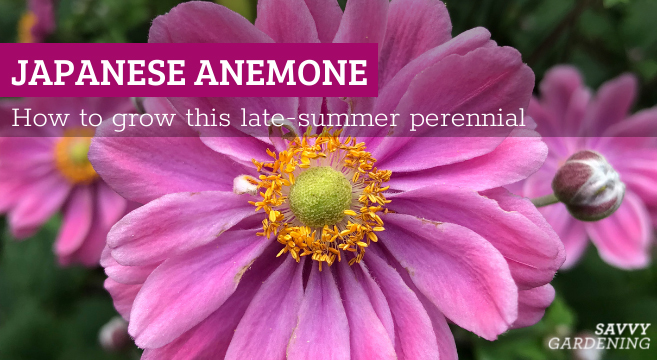This post may contain affiliate links. If you make a purchase through links on our site, we may earn a commission.
As the late-summer garden starts to reveal some of the last blooms of the season, my Japanese anemone is deciding it’s her time to shine. The end-of-summer performance is nearing its crescendo: a lovely, tall-yet-compact, floriferous perennial, covered in buds that open to reveal gorgeous blooms.
Native to various parts of Asia and naturalized throughout, this herbaceous perennial is part of the Ranunculaceae (buttercup) family. Japanese anemones are also called windflowers (among other types of anemones) because of the way the blooms sway in the wind. The flower stems are upright, long and firm, yet flexible, which is noticeable when you watch the bees land on the blooms… they just sort of bounce up and down.
The flowers’ petals are the shapes of buttercups, but larger. And the centers of the blooms are spectacular. The vibrant and sometimes thick yellow coronaria form a ring of stamens around the center mound comprised of pistils. On the flowers of the variety I grow, ‘Pamina’, those centers are lime green.

In this article, I’m going to explain why Japanese anemones make a gorgeous, addition to your perennial garden. Additionally, if one of your requirements is deer resistance, mine has never been bothered, and it’s planted near a deer thoroughfare on my property. And these bloom-filled wonders attract a ton of pollinators. My plant is always abuzz with bees in various shapes and sizes.
Planting your Japanese anemone
Wait until the soil has warmed up in the spring before planting a new Japanese anemone. Read the plant tag carefully. You’ll want to choose an area of the garden that gets part sun to part shade. The area should have moist, but well-draining soil. Amend the hole you dig with compost or manure, and amend the area around it well, too. If you’re planting more than one Japanese anemone, space them out so they’re about a foot or two apart.

Adding a layer of mulch around the base of the plant can help to conserve moisture. (It also helps keep the weeds down!)
It took about two or three years for my Japanese anemone to become established in its spot. One year when I posted a photo, someone warned me plants can be invasive. I’m happy the clump has gotten bigger and it’s still manageable. But plants do spread via underground rhizomes. My experience with rhizomous plants includes lily of the valley, which is horrible to try to remove. In my experience, my Japanese anemone has been slow growing and low maintenance. However I think it’s worth noting that depending on your garden’s conditions, your plant could spread more than you want it to. It’s worth choosing the location carefully—and keeping a close eye on your plant!

Caring for Japanese anemones
In the spring, carefully clear the dead foliage from around the Japanese anemone once all threat of frost has passed. Because the plant prefers warmer temperatures, and being a herbaceous perennial, it sometimes takes a while for the plant to get started in spring. I’ve been alarmed in the past that it may not have survived the winter, but then it will slowly start to make an appearance.
Lightly amend the soil around your plant, then wait for it to grow. Towards the middle of summer, you’ll start to see buds form. Depending on how big your plant gets each year, you may need to stake your plants. A heavy storm can cause those sturdy, wiry stems to droop.
Deadhead spent blooms once they’re done flowering to encourage more. And then allow the plant to die back over the winter.
As mentioned in my intro, Japanese anemones are deer resistant. They’re also rabbit resistant. Pest damage can occur from Japanese beetles or black blister beetles. (My plant has never been afflicted by either.)

Three Japanese anemone varieties to grow
‘Honorine Jobert’ (Anemone x hybrida)
‘Honorine Jobert’ is the cultivar that introduced me to Japanese anemones. Years ago, I saw one in a garden while out for a walk and had to figure out what it was. In 2016, it was named the Perennial Plant Association’s Perennial Plant of the Year. It is considered hardiness zone 4 here in Canada.

Anemone hupehensis var. japonica ‘Pamina’
‘Pamina’ is the pink Japanese anemone featured in the main photo and throughout this article. It’s the one I’m growing in my garden, so I get a front row seat to its beautiful blooms if I walk around to the side of my house. The double blooms sit atop a plant that grows to be about two to three feet (60 to 90 centimetres) tall. It also has an Award of Garden Merit from the Royal Horticultural Society (RHS).

Fall in Love™ ‘Sweetly’ Japanese anemone hybrid
The blooms of this variety from Proven Winners have semi double blooms. The plant is hardy down to USDA zone 4a and can be planted in an area that gets full sun to partial shade conditions.

Learn more about Japanese anemones in this video!
More late-blooming perennials
- Aster Purple Dome: A fall-blooming perennial for your garden
- Native white aster plants to add to your garden
- Late-season shrubs for fall beauty
- 5 late-blooming pollinator-friendly plants
- 10 of the longest flowering perennials for your garden




Leave a Reply